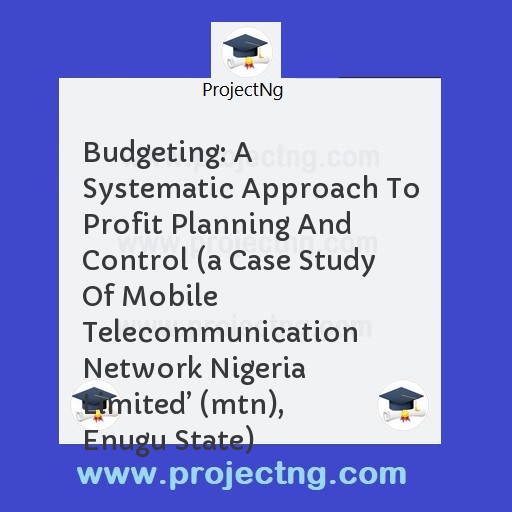Budgeting: A Systematic Approach To Profit Planning And Control (a Case Study Of Mobile Telecommunication Network Nigeria Limited’ (mtn), Enugu State)
Accounting Project Topics
Get the Complete Project Materials Now! »
BUDGETING: A SYSTEMATIC APPROACH TO PROFIT PLANNING AND CONTROL
(A CASE STUDY OF MOBILE TELECOMMUNICATION NETWORK NIGERIA LIMITED’ (MTN), ENUGU STATE)
ABSTRACT
Budgeting – A systematic approach to profit planning and control is a work centered on the use of budgeting as a tool for planning and control for profit maximization in a mobile telecommunication network Nigeria Limited Enugu as a case study.
The objective of the study is to show the importance of budgeting as a tool for systematic profit planning and control in the mobile telecommunication network Nigeria limited which has profit maximization as its principal objective.
The research is also aimed at identifying the steps adopted in the formulation of annual budget of MTN Nigeria.
Consequent upon this, the following hypothetical question were used for the study.
1. Managers use budgeting as a systematic approach to profit planning and control in attaining the goals of the business.
2. Decision making is performed in mobile telecommunication using budgeting
3. Utilization of resources is achieved with the use of budget and budgetary control
Following the investigation and analysis of data, the following findings were made
1. The organization uses budgeting in achieving the goals and objectives
2. The main objective of the organization is profit maximization
3. Efficiency and effectiveness of the organization is achieved through the use of budgeting.
From the findings, the conclusions were arrived that budgeting is very essential and indispensable tool for profit planning and control. It helps management to be well structured in sustaining the growth and expansion of the organization.
TABLE OF CONTENT
Title page i
Approval ii
Dedication iii
Acknowledgement iv
Abstract v
Table of content vi
CHAPTER ONE
1.0 Introduction 1
1.1 Historical Development of the Firm 4
1.2 Background of mobile Telecommunication 5
Network Nigeria Limited/Present state of Affairs
1.3 Statement of problem 8
1.4 Objective of the study 8
1.5 Research Question 9
1.6 Research Hypothesis 10
1.7 Scope and limitation 10
1.8 Significance of the study 11
1.9 Definition of terms 12
CHAPTER TWO
2.0 Literature review 14
2.1 Introduction 14
2.2 Definition of budget 15
2.3 Types of Budget 17
2.4 The Budget period 20
2.5 Administration of the Annual Budget 21
2.6 Stages in the Budget process 24
2.7 Appraisal of fixed, flexible and other budget 43
2.8 Planning function 45
2.9 Controlling function 46
2.10 Budgeting control 50
2.11 Variance analysis 51
2.12 Additional Tool for Budgeting and Budgetary
control: Zero Base Budgeting (ZBB) 57
CHAPTER THREE
3.0 Research Design and methodology 58
3.1 Research design 58
3.2 sampling technique 58
3.3 Sampling design and population size 58
3.4 Sources of data 60
3.5 Interview questions 60
3.6 Method of data analysis 60
CHAPTER FOUR
4.0 Presentation, Analysis and Interpretation of Data 63
4.1 Analysis of questionnaires returned 63
4.2 Hypothesis testing and proofing 71
CHAPTER FIVE
5.0 Summary of findings recommendations and conclusion 77
5.1 Summary of findings 77
5.2 Recommendations 79
5.3 Conclusion 80
Bibliography 81
Appendix 83
CHAPTER ONE
1.0 INTRODUCTION
The growing complexity of the business environment and the ever increasing competition among firms in the modern time, make planning an invaluable tool for business success. Successful management is no longer just a matter of flair, skill and determination, a conscious effort is needed to harness available resources towards the achievement of enterprise objectives. Budgeting is one of the tools adopted by management for effective cost planning and control.
A budget is commonly understood the forecast by a government, organization nor society of its expenditures and revenues for a specific period of time. The period covered by a budget is usually a year known as financial year. Budgeting is concerned with the utilization of financial resources to serve human needs. Although a budget may be characterized by a series of goals with price tags attached. It is mainly a mechanism for making choices among alternative expenditure. When such are coordinated so as to achieve desired goals, the budget becomes a plan. If there are specifications on how the goals are to be achieved, the budget becomes a psychological device to make administrators thin. If however, the emphasis is placed on achieving the desired objective at the lowest possible cost, then the budget is an instrument for ensuring efficiency.
An enterprise which is effectively and efficiently managed produces good and rewarding result. Management is efficient if it is able to accomplish the objectives with minimum efforts and costs.
Profit planning and control or budgeting is an integral part of management. The financial manager has a particular interest in profits planning and control because he helps to regulate flows of funds which is his function. The decision making process of management starts with planning. ‘Planning is the design of a desired future and of effective ways of bringing it about. In other words, planning involves the determination of the future course of action for accomplishing the objectives of the enterprise. The basic purpose of planning is to provide guidelines for making decisions. It is a forward process to reducing uncertainty about the future.
Planning is a continuous process which would generally involve four fundamental steps.
1. Establishing the objectives
2. Determining the goals
3. Developing strategies
4. Formulating profits plans or budget.
Objectives are the statements of broad and long term desired state or position of the enterprise in the future. They are directional and motivational in nature and are generally the qualitative expressions of the desired future state. For instance, the primary objective of an enterprise may be customers satisfaction, employee welfare, long-run- survival which depends upon the maximization of the long-run profit, that is wealth maximization.
Be the First to Share On Social

Enjoying our content?
Don't miss out on new videos! Subscribe to our YouTube channel for more awesome content.
Subscribe Now!













